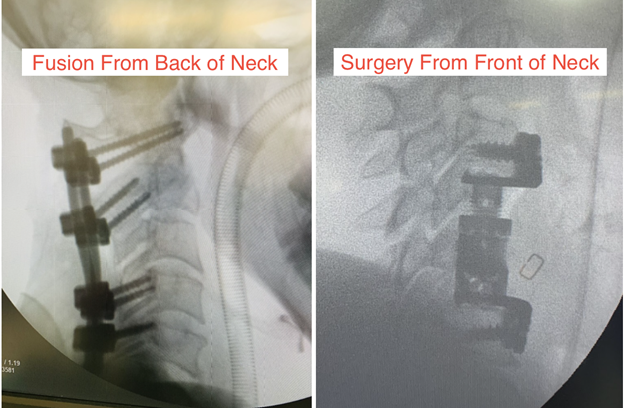Cervical Spine Surgery: Comprehensive Care for Neck Pain
Welcome to Snayu, where we specialize in a range of advanced procedures to treat cervical spine conditions. One of our key services is Cervical Spine Surgery, which includes both Cervical Spine Fusion and Disc Arthroplasty. If you’re experiencing severe neck pain, spinal instability, or related symptoms, our surgical options may provide the relief and stability you need.

What is Cervical Spine Surgery?

Cervical spine surgery encompasses various procedures designed to treat conditions affecting the neck (cervical spine). The primary goals are to alleviate pain, restore stability, and improve overall neck function. Two main types of surgeries we offer are Cervical Spine Fusion and Disc Arthroplasty. There is also the option of doing only Laminectomy (No Fusion) for compressive cervical spinal cord pathologies.
Cervical Spine Fusion
Cervical spine fusion is a surgical procedure that joins two or more vertebrae in the neck to eliminate motion between them. This can help relieve pain from conditions like degenerative disc disease, herniated discs, spinal stenosis, and fractures.
Cervical Sping Fusion Procedure
- Anesthesia: The procedure is typically performed under general anesthesia.
- Incision: A small incision is made in the front (anterior) or back (posterior) of the neck.
- Disc Removal: The damaged disc is removed to relieve pressure on the spinal cord and nerves.
- Bone Graft: A bone graft or bone graft substitute is placed between the vertebrae. This may be harvested from the patient (autograft) or from a donor (allograft).
- Stabilization: Metal plates, screws, or rods are used to stabilize the spine and facilitate the fusion process.
Benefits

Pain Relief: Significant reduction or elimination of chronic neck pain.

Stability: Improved spinal stability, reducing the risk of further injury.

Functionality: Enhanced ability to perform daily activities without pain.

Quick Recovery: As a minimally invasive procedure, Kyphoplasty typically involves a shorter recovery time compared to traditional surgery.

Disc Arthroplasty (Artificial Disc Replacement)
Disc arthroplasty, also known as artificial disc replacement, is a motion-preserving surgery designed for patients with specific cervical spine conditions. This procedure involves replacing a damaged disc with an artificial one, allowing for continued movement between the vertebrae.
Disc Arthroplasty Procedure
- Anesthesia: The procedure is typically performed under general anesthesia.
- Incision: A small incision is made in the front of the neck.
- Disc Removal: The damaged disc is removed to relieve pressure on the spinal cord and nerves.
- Artificial Disc Placement: An artificial disc is implanted in place of the removed disc, allowing for natural motion and flexibility.
Benefits

Motion Preservation: Unlike fusion, disc arthroplasty allows for continued movement between the vertebrae.

Pain Relief: Effective in reducing pain caused by degenerative disc disease and herniated discs.

Improved Functionality: Maintains natural neck movement and function.
Some Frequently Asked Questions
What conditions are treated with cervical spine fusion?
Cervical spine fusion is typically used to treat conditions such as degenerative disc disease, herniated discs, spinal stenosis, and fractures that cause instability and chronic neck pain.
How long does the fusion process take?
Bone fusion can take several months to complete. While the initial recovery period is about 4-6 weeks, full fusion and stabilization may take 6-12 months.
Are there limitations after cervical spine fusion?
Patients should avoid heavy lifting, bending, and twisting movements for several months. Your surgeon will provide specific guidelines based on your progress.
Will I lose neck mobility after fusion?
Cervical spine fusion reduces motion at the fused segment, but most patients do not notice significant changes in overall neck mobility since only a small section is fused.
Can the fusion fail?
While cervical spine fusion has a high success rate, there is a small risk of non-union (when the bones do not fuse properly), which may require additional treatment.
What conditions are treated with disc arthroplasty?
Disc arthroplasty is primarily used to treat cervical disc degeneration and herniated discs in patients who are good candidates for a motion-preserving procedure.
How does disc arthroplasty differ from fusion?
Unlike fusion, which eliminates movement at the fused segment, disc arthroplasty preserves natural motion in the cervical spine by replacing the damaged disc with an artificial one.
What is the recovery time for disc arthroplasty?
Recovery from disc arthroplasty is often quicker than fusion, with many patients resuming normal activities within a few weeks and full recovery typically taking 6-8 weeks.
Are there activity restrictions after disc arthroplasty?
Patients should avoid high-impact activities and heavy lifting for the first few weeks. Your surgeon will provide detailed activity guidelines based on your recovery.
What are the risks associated with disc arthroplasty?
Risks include infection, nerve damage, and issues with the artificial disc, such as dislocation or wear over time. However, disc arthroplasty is generally safe and effective for suitable candidates.
Is disc arthroplasty suitable for everyone?
Not all patients are candidates for disc arthroplasty. Ideal candidates are typically younger, active individuals with isolated disc disease and no significant spinal instability or deformity. A thorough evaluation by your surgeon will determine if this procedure is right for you.
Visit to make an appointment

Best Multispeciality Hospital in Kolkata
JC-16 & 17, No. 3A, Broadway Rd, opp. to Stadium Gate, Sector 3, Bidhannagar, Kolkata

